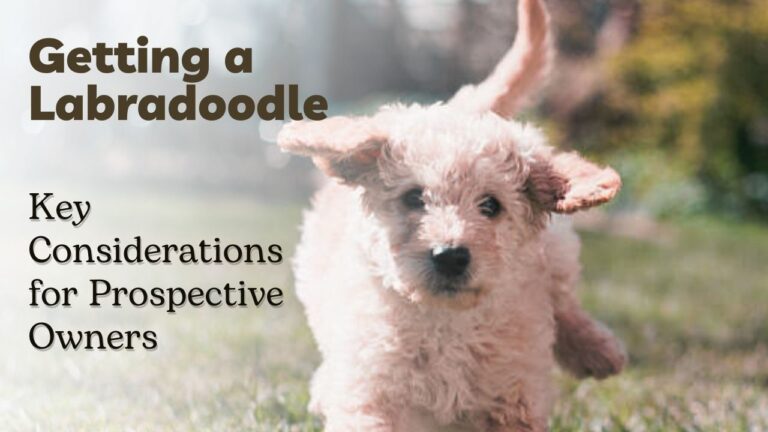So, you’ve caught wind of the curly-coated sensation that’s been wagging its tail across the globe?
The Labradoodle. Sounds fancy, doesn’t it? It’s not just a fun name to say but represents a blend of two of the most cherished breeds: the Labrador Retriever and the Poodle.
This delightful crossbreed emerged not merely as a style statement but to combine the best attributes of its parent breeds. The result? A lovable, intelligent, and sometimes wavy-haired companion.
But before you decide to welcome this canine sensation into your life, there’s more to consider than just its cute face. Let us know more about Labradoodle’s history, and learn everything you should know before buying/adopting a labradoodle.
Understanding the Labradoodle Breed
The Labradoodle is not a product of mere whimsy but rather a thoughtful combination of the Labrador Retriever and the Poodle. But why bring these two distinct breeds together?
The story begins in the late 1980s in Australia. The aim was to create a breed that combined the trainability and affability of the Labrador Retriever with the low-shedding coat of the Poodle.
The intent? To provide a guide dog suitable for people with allergies, especially to dog dander. Thus, the Labradoodle was born out of necessity, not fashion.
Wally Conron, working for the Royal Guide Dogs Association of Australia, is credited for this intentional breeding. He succeeded in his mission, and the first Labradoodle, named Sultan, became a guide dog for a vision-impaired woman whose husband had allergies.

Physical Characteristics
When you decide to step into the world of Labradoodles, you’re not just meeting a ‘one-size-fits-all’ dog. There’s a delightful array of sizes and appearances to get acquainted with.
Sizes: Labradoodles Come in Three primary Sizes:
- Miniature: Standing between 14 to 16 inches at the shoulder and weighing approximately 15 to 25 pounds, the Miniature Labradoodle is ideal for those who might have limited space but want a big-hearted companion.
- Medium: These dogs measure around 18 to 20 inches in height and can weigh between 30 to 45 pounds. They strike a perfect balance, not too big, not too small, just right for many families.
- Standard: The largest of the Labradoodles, they stand tall at 22 to 24 inches and can weigh anywhere from 50 to 65 pounds. Their size might be intimidating for some, but their gentle nature remains consistent across the board.
Coat Types and Colors: There are Three Primary Coat Types:
- Wool: Similar to a Poodle, this type is tight and curly.
- Fleece: This is a wavy, flowing coat that’s soft to the touch.
- Hair: More reminiscent of the Labrador Retriever, it’s straighter and can sometimes shed.
As for colors, the palette is broad. Labradoodles can be found in a spectrum of shades, from gold, cream, and apricot to chocolate, black, and even multi-colored or “parti.”
Key Considerations Before Buying
Buying a labradoodle isn’t just about understanding the responsibilities and costs associated with owning a Labradoodle. Let’s break it down.
Costs Involved
The Labradoodle, being a sought-after breed, can come with a significant price tag. Depending on the breeder’s reputation, location, and the dog’s lineage, the initial cost can range from $1,000 to $3,000, or even more for select lineages.
This cost often includes initial vaccinations, microchipping, and sometimes even early-stage training or socialization classes. Now, the expenses don’t stop at the purchase. There are many recurring costs to consider:
- Food: A Labradoodle is an active dog with dietary needs that change as it grows. High-quality dog food that meets its nutritional requirements can set you back anywhere from $40 to $70 a month.
- Veterinary care: Routine check-ups, vaccinations, emergency visits, and preventative medications can add up. On average, anticipate around $500 to $1,000 a year, though this can spike with unforeseen health issues.
- Grooming: Their unique coat requires regular grooming. Depending on coat type, you might need professional grooming every 2 to 3 months, which can range from $50 to $100 a session.
- Miscellaneous: Toys, bedding, training classes, boarding or pet-sitting fees, and other miscellaneous expenses can add another few hundred dollars annually.
Time and Commitment
- Training needs: Labradoodles are intelligent and eager to please, but this doesn’t exempt them from the need for consistent training. During puppyhood, they can be especially energetic, necessitating structured training sessions. Puppy training classes, crate training, housebreaking, and basic command training are essential.
- Socialization: This breed thrives on social interaction. From a young age, Labradoodles should be exposed to various environments, people, and other animals. This ensures they grow up to be well-rounded and well-behaved adults. Regular trips to dog parks, playdates, and even simple walks around the neighborhood can significantly benefit their social skills.
Finding a Reputable Breeder
Red flags: Be wary of breeders who have multiple litters available all the time, don’t provide clear health histories of the parent dogs, or are unwilling to show you their breeding facilities. Avoid those who push for a quick sale without ensuring you’re a suitable owner.
Questions to ask:
- What health tests have been done on the parent dogs?
- Can I meet the puppy’s parents or at least the mother?
- What is your experience and history with breeding Labradoodles?
- What is your process for socializing puppies?
- What is included with the purchase (e.g., vaccinations, initial training)?
- Can you provide references from previous buyers?
Who is This Dog Not For?
- Individuals lacking time: Labradoodles thrive on interaction and can develop behavioral issues if neglected.
- Those unwilling to train: Consistent training is paramount for a harmonious relationship.
- Apartment dwellers without access to open spaces: While adaptable, Labradoodles need room to expend their energy.
- People with tight budgets: The ongoing costs can be a strain for some.
Living with a Labradoodle: What to Expect
Bringing a Labradoodle into your home is akin to inviting a ball of energy, intelligence, and affection into your life. But what exactly does life look like when shared with this vibrant breed? Here’s a glimpse.

Training and Socialization
Begin training from puppyhood. Labradoodles, with their sharp minds, are like sponges in their early months, absorbing and learning from their environment. Starting early not only makes the training process smoother but also establishes a bond of trust and respect between you and your pup.
Tips for effective training methods:
- Positive Reinforcement: Rewarding good behavior with treats or praise ensures your Labradoodle is eager to learn.
- Consistency: Make sure all family members are on the same page regarding commands and rules.
- Short Sessions: Break the training into short, frequent sessions to keep your puppy’s attention.
- Social Exposure: Introduce your Labradoodle to different environments, sounds, and experiences to ensure they’re well-adjusted adults.
Interaction with Children and Other Pets
Labradoodles are renowned for their affable disposition, making them excellent companions for families, even those with children and other pets. Their playful demeanor and patient nature often make them a favorite among kids.
However, like with all breeds, it’s essential to ensure supervised interactions, especially with younger children who might not understand a dog’s boundaries. When introducing a Labradoodle to other pets, do so in a neutral space and allow both parties to acclimate at their own pace.
While Labradoodles generally gel well with other animals, individual personalities can vary, so gradual introductions are key.
Labradoodles as Service or Therapy Dogs
Labradoodles aren’t just about looks; they’ve got brains and a big heart to boot. Their inherent intelligence, combined with their intuitive ability to pick up on human emotions, makes them excellent candidates for therapy and service roles.
The benefits, however, are manifold. Not only do these roles provide essential services to those in need, but they also offer Labradoodles a sense of purpose, which they relish. Furthermore, their hypoallergenic coats make them especially valuable in environments like hospitals, where minimizing allergens is crucial.
Essential Items to Have Before Bringing a Puppy Home
- Crate: A safe space for your puppy to sleep and rest.
- Bedding: Soft bedding for the crate or sleeping area.
- Food and Water Bowls: Preferably stainless steel or ceramic.
- Puppy Food: Consult with a vet for the best nutritional choices.
- Collar and Leash: Adjustable to fit as the puppy grows.
- Identification Tag: With puppy’s name and your contact information.
- Puppy Pads: For house training purposes.
- Chew Toys: To satisfy teething urges and reduce destruction.
- Grooming Supplies: Brush, puppy shampoo, nail clippers.
- Stain and Odor Remover: Accidents will happen; be prepared.
- Puppy Training Treats: For positive reinforcement during training.
- Baby Gates or Playpen: To create safe zones in your home.
- First Aid Kit: Specific to canine needs.
- Interactive Toys: To keep the puppy mentally stimulated.
- Flea and Tick Prevention: Consult with a vet for the best options.
- Blanket or Comfort Object: To comfort the puppy in its new environment.
Remember, it’s always a good idea to puppy-proof your home before the arrival of your new companion, ensuring that potential hazards are out of reach and the environment is safe and welcoming.
Conclusion
Owning a labradoodle isn’t just about flaunting those gorgeous curls at the dog park. It’s about understanding, commitment, and mutual respect.
If you’re considering bringing a Labradoodle into your life, make sure it’s not just a fleeting fancy but a well-informed decision. Because, when given the right environment and care, a Labradoodle isn’t just a pet; it becomes a cherished family member, offering years of love, laughter, and unforgettable memories.
Here’s to making informed choices and embracing the joy of pet ownership!

